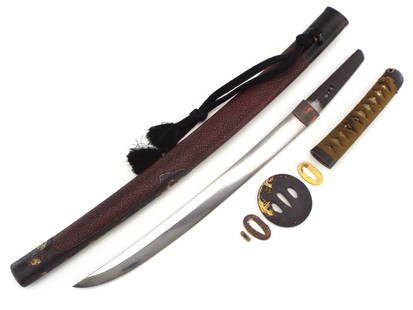
Early 17th Century Shinto Era Wakizashi Blade in Shin
Similar Sale History
View More Items in Weapons & Armor

Related Weapons & Armor
More Items in Weapons & Armor
View MoreRecommended Collectibles
View More



Item Details
Description
This is a finely-forged Japanese wakizashi blade, measuring 21_ from ÒkissakiÓ(tip) to the habaki stop, and 26 1/2Ó long overall (not including grip). This magnificent sword dates to the early Shinto Ònew swordsÓ era, approx. 1600-1650 (Edo Period). The blade is ÒO-suriageÓ, meaning that it likely started life as a katana blade, and was cut down at the tang to its current length. The end of the tang shows a small portion of the original hole for the ÒmekugiÓ (the peg retaining the grip), and two new mekugi holes have been added | | The blade collar bears two mons or markings. The first appears to be a mon of the Tokugawa shogunsÑthree hollyhock leaves inside a circle representing the Matsudaira clan with the Tokugawa family crest. The second is yet unidentified by the owner | | The blade bears a deep ÒhiÓ (fuller) on both faces, which extends along the tang beneath the current grip, further attesting to its modification. The blade shows fine grain under magnification, with a distinct ÒhamonÓ delineating the cutting edge. The antique blade may have more modern mountings for use by an officer or NCO. This grip is wood covered with white ray skin and wrapped with gold silk cord, with brass ÒmenukiÓ (ornaments) in the form of a cherry blossom inserted beneath the wrapping. The cherry blossom motif continues on the pommel, the ÒtsubaÓ and the ÒhabakiÓ. The wakizashi is housed in a very nice wood scabbard with a leather combat cover. The Wakizashi is in good condition. The blade shows a single small ding away from the edge on the reverse face, as well as patches of light oxidation, with no pitting apparent. The wrapping of the grip shows some wear from use, and the scabbard shows some age wear and staining, else very good. Wakizashis and Katanas are traditionally made from a specialized Japanese steel called tamahagane, which is created from a traditional smelting process that results in several, layered steels with different carbon concentrations. This process helps remove impurities and even out the carbon content of the steel. The age of the steel plays a role in the ability to remove impurities, with older steel, having a higher oxygen concentration, being more easily stretched and rid of impurities during hammering, resulting in a stronger blade. The smith begins by folding and welding pieces of high and low carbon steel several times to work out most of the impurities. The resulting block of steel is then drawn out to form a billet. At this stage, it is only slightly curved or may have no curve at all. The gentle curvature of a katana is attained by a process of differential hardening or differential quenching: the smith coats the blade with several layers of a wet clay slurry, which is a special concoction unique to each sword maker, but generally composed of clay, water and any or none of ash, grinding stone powder, or rust. The edge of the blade is coated with a thinner layer than the sides and spine of the sword, heated, and then quenched in water (some sword makers use oil to quench the blade). The slurry causes only the bladeÕs edge to be hardened and also causes the blade to curve due to the difference in densities of the micro-structures in the steel. When steel with a carbon content of 0.7 percent is heated beyond 750 ¡C, it enters the austenite phase. When austenite is cooled very suddenly by quenching in water, the structure changes into martensite, which is a very hard form of steel. When austenite is allowed to cool slowly, its structure changes into a mixture of ferrite and pearlite which is softer than martensite. This process also creates the distinct line down the sides of the blade called the hamon, which is made distinct by polishing. Each hamon and each smithÕs style of hamon is distinct. After the blade is forged, it is then sent to be polished. The polishing takes between one and three weeks. The polisher uses finer and finer grains of polishing stones in a process called glazing, until the blade has a mirror finish. However, the blunt edge of the sword is often given a matte finish to emphasize the hamon.
Condition
The Wakizashi is in good condition. The blade shows a single small ding away from the edge on the reverse face, as well as patches of light oxidation, with no pitting apparent. The wrapping of the grip shows some wear from use, and the scabbard shows some age wear and staining, else very good.
Dimensions
38.25 x 2.5 x 2 in
Weight
3 lb
Buyer's Premium
- 20%
Early 17th Century Shinto Era Wakizashi Blade in Shin
Estimate $1,500 - $3,000
5 bidders are watching this item.
Shipping & Pickup Options
Item located in Gallatin, Tennessee, usSee Policy for Shipping
Payment

TOP














































































